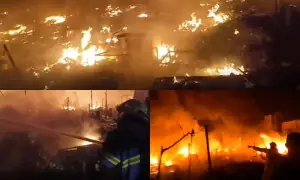Italy’s ski industry fires cannon against climate change
MONTE CIMONE: Italy Monte Cimone, a popular ski resort in Italy’s Apennine Mountains, invested 5 million euros in artificial snowmaking before the winter season in an attempt to stave off the impact of global warming. The money was largely wasted.
The snow cannon proved useless because the water droplets they fire into the air need freezing weather for them to fall to the ground as snow, and until mid-January the temperature never fell below zero Celsius (32 Fahrenheit).
“The ski-lifts were closed, the ski instructors and seasonal workers had nothing to do and we lost 40% of our revenue for the whole season,” said Luciano Magnani, head of the local consortium of ski tourism operators.
“It was the first time in 40 years that we were closed for the Christmas holidays.”
Rising temperatures threaten the skiing industry worldwide but Italy, with its many relatively low-altitude resorts in the Apennines as well as the Alps, is particularly badly affected.
Some 90% of Italy’s pistes rely on artificial snow, compared with 70% in Austria, 50% in Switzerland and 39% in France, according to data from Italian Green lobby Legambiente.
The repercussions threaten the environment, the economy and local livelihoods.
Rising temperatures in Europe are bringing drought and Italy can ill afford the millions of cubic metres of water it uses every year to make snow.
Legambiente calculates that the annual water consumption of Italy’s Alpine pistes may soon be as much as a city of a million people, such as Naples.
The energy consumed by an ever-growing battery of snow cannon is also exorbitant.
The power required to provide artificial snow to all Europe’s Alpine resorts would equal the annual consumption of 130,000 families of four people, said Mario Tozzi, a geologist and conservationist.
RESIST OR CHANGE?
The skiing industry faces a looming decision: battle on in the hope technological progress can overcome the effect of rising temperatures, or change the business model and look for alternative sources of tourist revenue.
While climatologists and even the Bank of Italy suggest the second course of action, most ski operators are defiant.
“Without skiing, the mountain communities will lose their economic foundation and people will leave,” said Valeria Ghezzi, head of Italy’s association of ski-lift operators (Anef), which includes 300 companies and covers 90% of the market.
The economic stakes are high. Italy’s ski sector directly or indirectly employs 400,000 people and generates turnover of 11 billion euros ($11.92 billion), according to Anef data, equal to about 0.5% of national output.
Italy has around 220 ski resorts with at least five lifts, putting it third in the world behind the United States and France, according to the 2022 International Report on Snow and Mountain Tourism. It also receives the third highest number of foreign tourists behind Austria and France.
Italy started to develop artificial snow machines around 1990 after two almost snowless years in the Alps. It is now a world leader. One of its main producers, TechnoAlpin, supplied the 2022 Winter Olympic games in Beijing.
“In the late 1980s no-one was talking about climate change, but instead of despairing we showed the first and greatest form of resistance, we started to build snow cannons,” Ghezzi said.
Ski-making technology is in constant evolution. TechnoAlpin’s latest machine can produce snow at 10 C (50 F). It is testing the device on nursery slopes at Bolbeno, Italy’s lowest resort at an altitude of just 600 metres (1,970 feet).
Bolbeno’s mayor Giorgio Marchetti said the snow it produces was “wonderful” and remained on the ground even in warm temperatures.
Italy is far from alone in going to almost any lengths to preserve its winter skiing.
In December authorities in the Swiss resort of Gstaad used helicopters to deposit snow onto a strategic but bare piste connecting the ski areas of Zweisimmen e Saanenmoser, which were themselves furnished with artificial snow from cannon.
PROTESTS
But the increasingly desperate attempts to preserve the ski industry are drawing protests from environmentalists.
Last month activists with flags and banners gathered at Pian del Poggio, in Italy’s Apennines, to protest against the installation of snow cannon at the 1,300 metre high resort.
Five Spanish environmentalist groups are lobbying the European Union to block the use of 26 million euros of EU money to fund a project to join two ski resorts in the fast- warming Pyrenees mountain range.
Some economists and climatologists argue that trying to keep low-altitude ski resorts in business is destined to fail, and snow-making merely delays the inevitable.
“Even if artificial snow can reduce the financial losses from occasional instances of snow-deficient winters, it cannot protect against systemic long-term (climate) trends,” Bank of Italy researchers said in a report in December.
“In this context adaptation strategies based on diversification of mountain activities and revenues are crucial,” the report said.
The European Alps, where temperatures are rising faster than in most of the world, will become increasingly popular in summer as Mediterranean beaches and cities grow uncomfortably hot, climate and tourism experts forecast.
Giulio Betti, a climatologist at Italy’s National Research Council, said that skiing between 1,000 and 2,000 metres will soon be “economically unsustainable,” and resorts should focus instead on attracting different kinds of holidaymakers.
A growing number of mountain communities have already followed the advice.
In the Piani di Artavaggio, a 1,600 metre-high resort 100 km (63 miles) north of Milan, the authorities dismantled the ski-lifts 16 years ago while improving facilities for hikers, mountain-bikers and ordinary day-trippers.
The village of Elva, whose 88 inhabitants live at 1,600 metres in the Maira Valley near the French border, has also eschewed ski-lifts in favour of mountaineering and hiking.
The village has been awarded 20 million euros of EU funds under Italy’s COVID-19 recovery plan, which mayor Giulio Rinaudo says he will use to boost ecological tourism based on history, gastronomy and nature.
“Ski-lifts and cable cars tie you hand and feet to the snow,” Rinaudo said. “We are trying to diversify.”
For the latest news, follow us on Twitter @Aaj_Urdu. We are also on Facebook, Instagram and YouTube.





















Comments are closed on this story.